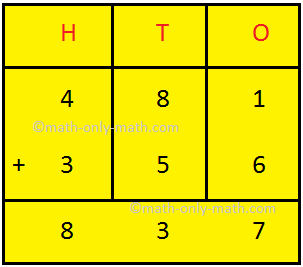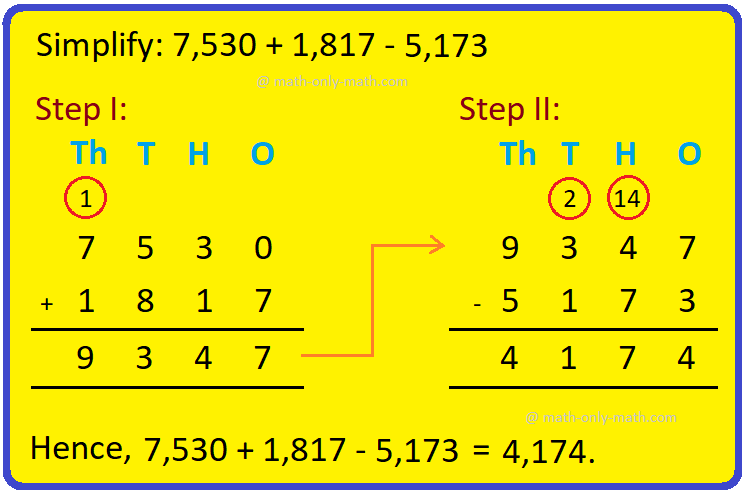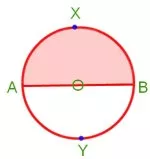Subscribe to our YouTube channel for the latest videos, updates, and tips.
Home | About Us | Contact Us | Privacy | Math Blog
Locus of a Moving Point
In locus of a moving point, we will learn;
- locus and equation to a locus
- method of obtaining the equation of the locus
- how to determine the locus of a moving points that will satisfy the condition.
Locus and Equation to a Locus:
If a point moves on a plane satisfying some given geometrical condition then the path trace out by the point in the plane is called its locus. By definition, a locus is determined if some geometrical condition are given. Evidently, the co-ordinate of all points on the locus will satisfy the given geometrical condition. The algebraic form of the given geometrical condition which is satisfy by the co-ordinate of all points on the locus is called the equation to the locus of the moving point. Thus, the co-ordinates of all points on the locus satisfy its equation of locus: but the co-ordinates of a point which does not lie on the locus, do not satisfy the equation of locus. Conversely, the points whose co-ordinates satisfy the equation of locus lie on the locus of the moving point.
Examples of Locus
of a Moving Point:
1. A point moving in such a manner that three times of distance from the x-axis is grater by 7 than 4 times of its distance form the y-axis; find the equation of its locus.
Solution:
Let P (x, y) be any position of the moving point on its locus. Then the distance of P from the x-axis is y and its distance from the y-axis is x.
By problem, 3y – 4x = 7,
Which is the required equation to the locus of the moving point.
2. Find the equation to the locus of a moving point which is always equidistant from the points (2, -1) and (3, 2). What curve does the locus represent?
Solution:
Let A (2, -1) and B (3, 2) be the given points and (x, y) be the
co-ordinates of a point P on the required locus. Then,
PA2 = (x - 2)2 + (y + 1)2 and PB2 = (x - 3)2 + (y - 2)2By problem, PA = PB or, PA2 = PB2
or, (x - 2)2 + (y + 1)2 = (x - 3)2 + (y - 2)2
or, x2 - 4x + 4 + y2 + 2y + 1 = x2 – 6x + 9 + y2 – 4y + 4
or, 2x + 6y = 8
or, x + 3y = 4 ……… (1)
Which is the required equation to the locus of the moving point.
Clearly, equation (1) is a first degree equation in x and y; hence, the locus of P is a straight line whose equation is x + 3y = 4.
3. A and B are two given point whose co-ordinates are (-5, 3) and (2, 4) respectively. A point P moves in such a manner that PA : PB = 3 : 2. Find the equation to the locus traced out by P. what curve does it represent?
Solution: Let (h, k) be the co-ordinates of any position of the moving point on its locus. By question,
PA/PB = 3/2or, 3 ∙ PB = 2 ∙ PA
or, 9 ∙ PB2 = 4 ∙ PA2
Or, 9[(h - 2)2 + (k - 4)2] = 4[(h + 5)2 + (k - 3)2]
or, 9 [h2 - 4h + 4 + k2 - 8k + 16] = 4[h2 + 10h + 25 + k2 - 6k + 9]
Or, 5h2 + 5k2 – 76h – 48k + 44 = 0
Therefore , the required equation to the locus traces out by P is
5x2 + 5y2 – 76x – 48y + 44 = 0 ……….. (1)
We see that the equation (1) is a second degree equation in x, y and its coefficients of x2 and y2 are equal and coefficients of xy is zero.
Therefore, equation (1) represents a circle.
Therefore, the locus of P represents the equation of a circle.
4. Find the locus of a moving point which forms a triangle of area 21 square units with the point (2, -7) and (-4, 3).
Solution: Let the given point be A (2, -7) and B (-4, 3) and the moving point P (say), which forms a triangle of area 21 square units with A and B, have co-ordinates (x, y). Thus, by question area of the triangle PAB is 21 square units. Hence, we have,
Therefore, the required equation to the locus of the moving point is 5x + 3y = 10 or, 5x + 3y + 21 = 0.
½ | (6 – 4y - 7x) – ( 28 + 3x + 2y) | = 21or, |6 – 28 - 4y – 2y - 7x – 3x | = 42
or, 10x + 6y + 22 = ±42
Therefore, either, 10x + 6y + 22 = 42 i.e., 5x + 3y = 10
or, 10x + 6y + 22 = - 42 i.e., 5x + 3y + 32 = 0
5. The sum
of the distance of a moving point from the points (c,0) and (-c, 0) is
always 2a units. Find the equation to the locus of the moving point.
Solution:
Let P be the moving point and the given points be A (c,0) and B (-c, 0). If (h, k) be the co-ordinates of any position of P on its locus then by question,
PA + PB = 2aor, PA = 2a - PB
or, PA2 = 4a2 + PB2 – 4a ∙ PB
or, PA2 – PB2 = 4a2 – 4a ∙ PB
or, [(h - c)2 +(k - 0)2] - [(h + c)2 +(k - 0)2] = 4a2 – 4a. PB
or, -4hc = 4a2 – 4a∙PB
or, a ∙ PB = a2 + hc
or, a2 ∙ PB2 = (a2 + hc)2 (squaring both sides)
or, a2 [(h + c)2 + (k - 0)2] = (a2 + hc)2
or, a2 [h2 + c2 + 2hc + k2] = a4 + 2a2hc + h2c2
or, a2h2 – h2c2 + a2k2 = a4 – a2c2
or, (a2 – c2)h2 + a2k2 = a2 (a2 – c2)
or, h2/a2 + k2/a2 – c2 = 1
Therefore, the required equation to the locus of P is x2/a2 + y2/(a2 – c2) = 1
● Locus
- Concept of Locus
- Concept of Locus of a Moving Point
- Locus of a Moving Point
- Worked-out Problems on Locus of a Moving Point
- Worksheet on Locus of a Moving Point
- Worksheet on Locus
From Locus of a Moving Point to Home Page
Didn't find what you were looking for? Or want to know more information about Math Only Math. Use this Google Search to find what you need.
Recent Articles
-
5th Grade Circle Worksheet | Free Worksheet with Answer |Practice Math
Jul 11, 25 02:14 PM
In 5th Grade Circle Worksheet you will get different types of questions on parts of a circle, relation between radius and diameter, interior of a circle, exterior of a circle and construction of circl… -
Construction of a Circle | Working Rules | Step-by-step Explanation |
Jul 09, 25 01:29 AM
Construction of a Circle when the length of its Radius is given. Working Rules | Step I: Open the compass such that its pointer be put on initial point (i.e. O) of ruler / scale and the pencil-end be… -
Combination of Addition and Subtraction | Mixed Addition & Subtraction
Jul 08, 25 02:32 PM
We will discuss here about the combination of addition and subtraction. The rules which can be used to solve the sums involving addition (+) and subtraction (-) together are: I: First add -
Addition & Subtraction Together |Combination of addition & subtraction
Jul 08, 25 02:23 PM
We will solve the different types of problems involving addition and subtraction together. To show the problem involving both addition and subtraction, we first group all the numbers with ‘+’ and… -
5th Grade Circle | Radius, Interior and Exterior of a Circle|Worksheet
Jul 08, 25 09:55 AM
A circle is the set of all those point in a plane whose distance from a fixed point remains constant. The fixed point is called the centre of the circle and the constant distance is known






New! Comments
Have your say about what you just read! Leave me a comment in the box below. Ask a Question or Answer a Question.